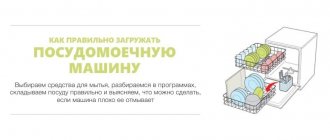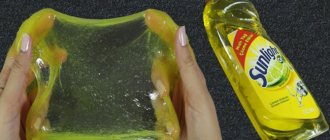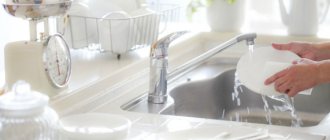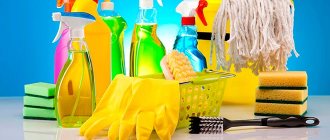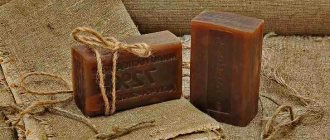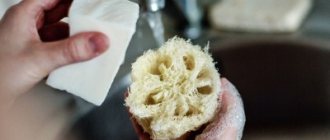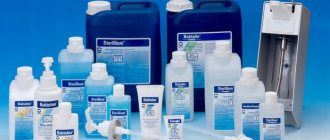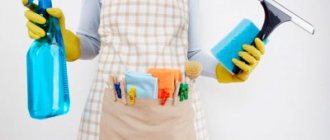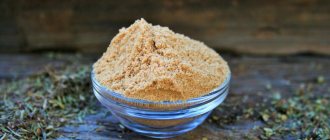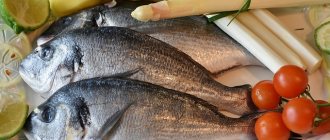Dishwashing detergent - their compositions and a testing review of these components in our article will show which of them is best used for cleaning children's and adult dishes, and which are unacceptable in household care. Further in addition to the video in this article
Detailed instructions will be offered on how to use certain means to avoid negative consequences.
Composition and properties of detergents
In preparation for the research work, we studied the literature and started with the encyclopedia [2], which contains basic concepts and terms on this topic. You can read about the composition of detergents in “General Chemistry” by N. Glinka [3]. The works of Z. Shpausus [7] and L. Chalmers [5] consider the composition of detergents and their use in everyday life and industry. In the books of Ambrazon A.A. [1], Schwartz A. and Peri D. [6] talk about surfactants, their characteristics and applications.
“Loving and respecting” dishes means washing and cleaning them thoroughly and on time. This seemingly simple matter also has its secrets.
Specialty dishwashing detergents first appeared in the 1950s. Hand dishwashing detergents are available in liquid or gel form. Gel products are considered more effective than liquid products. The main properties of the product is its cleaning ability. A big plus of the product is its ability to effectively cope with oil and grease stains in cold water, this is achieved through the selection of the optimal composition of surfactants.
The operation of washing in water with the participation of a detergent is known to everyone as very simple and easy to master. Outwardly and practically this is true. Nevertheless, a whole complex of physicochemical processes, hidden from our eyes, but interconnected into a single system, occurs in the washing solution. These processes were studied in detail by our scientists, especially P.A. Rebinder, D.A. Rozhdestvensky, B.N. Tyutyunnikov.
The washing process comes down to three stages. It is necessary: firstly, to separate (tear off) dirt particles from the surface to be cleaned to which they have stuck; secondly, transfer the separated water-insoluble mud particles into the washing solution, that is, “dissolve” them, as it were; thirdly, keep these floating particles in the cleaning solution until it is changed and eliminate any possibility of their re-sedimentation and adhesion to the surface being washed.
Water is mainly used as a liquid in everyday life. A good cleaning system should perform a dual function: remove dirt from the surface being cleaned and transfer it into an aqueous solution. This means that the detergent must also have a dual function: the ability to interact with the pollutant and transfer it into water or an aqueous solution.
Therefore, a detergent molecule must have hydrophobic and hydrophilic parts. Phobos - in Greek means fear, fear. So, hydrophobic means afraid, avoiding water. Phileo - in Greek - love, and hydrophilicity - loving, holding water. The hydrophobic part of the detergent molecule has the ability to interact with the surface of the hydrophobic contaminant.
The hydrophilic part of the detergent interacts with water, penetrates into the water and carries with it a particle of pollutant attached to the hydrophobic end. The basis of the detergent is surfactants (surfactants) that have the ability to be adsorbed on the boundary surface.
Surfactants are divided into two types: ionic and non-ionic (non-ionic). The fundamental difference is that nonionic surfactants are not subject to electrolytic dissociation, i.e., they do not decompose in water into positively and negatively charged ions; ionic surfactants, when interacting with water, decompose into ions, some of which have adsorption (surface) ) activity, others (counterions) are adsorption inactive.
Ionic surfactants are called anionic if the surfactant ions carry a negative charge, and cationic if the surfactant ions are positively charged. Some surfactants, depending on the conditions under which they are used, exhibit either anionic or cationic properties, which is why they are called amphoteric or ampholytic.
Anionic surfactants are organic acids and their salts. Cationic - bases, usually amines, and their salts. Anionic substances make up the majority of the world's surfactant production. Cationic and amphoteric substances have limited use and constitute a small share of the total production of surfactants.
Almost all modern dishwashing detergents contain a complex of anionic and nonionic surfactants designed to combat various types of contaminants. Experts say that it is the combination of these two groups of active substances that increases the effectiveness of the detergent.
It is best to wash dishes with hot (40-50 oC) water; exceptions are made only for products made of crystal, which darkens and can become cloudy in hot water, and earthenware, the glaze of which can withstand only warm water, and quickly cracks in hot water.
Commercially available detergents are rarely pure substances. They usually contain other ingredients, such as water softeners and bleaches, that increase their effectiveness. Some detergents contain enzymes that remove insoluble protein contaminants, organic bactericides (hexachlorophene, trichlorocarbanilide, etc.), foam stabilizers (for example, alkylamides). Many detergents add aromatic substances (fragrances) to eliminate unpleasant odors and give the washed surface a fresh aroma.
True, the smell of an apple, lemon or, for example, wild berries does not mean the presence of extracts of the above-mentioned fruits in this product. Dishwashing detergents may contain substances that soften the negative effects on the skin of the hands. The most common additives are glycerin, silicone and plant extracts. Glycerin and silicone have a similar effect; they create a protective film on the skin that prevents it from drying out. Moisture evaporates from wet skin much more intensely than from dry skin, so during prolonged contact with water, the skin needs protection.
At the same time, the surface film created by silicone can protect against the penetration of substances harmful to the skin contained in the detergent. Plant extracts soften the skin, have a calming effect, and relieve irritation that can be caused by individual components of surfactants (for example, aloe vera milk has this effect).
But even with all the undoubted advantages of these supplements, it is impossible to guarantee complete safety for your skin. It is worth noting that manufacturers' statements that the pH level of their products is 5.5 cannot in any case guarantee the absence of irritation, especially for people prone to allergies. Therefore, your skin needs protection while washing dishes. Even if the product contains softening components, do not forget that your hands can be protected from the harmful effects of the product using ordinary rubber gloves.
Safe composition: myth or reality?
High efficiency and safety of dishwashing detergents requires precise selection of the composition of the preparations. The safest are those designed for children's dishes and environmentally friendly.
But these funds have their own characteristics:
- They don't foam so well.
- They have an inconspicuous whitish, yellowish or grayish tint, as they do not contain dyes.
- They do not emit a pleasant aroma, since they contain no fragrances.
- They may not be able to cope with long-standing complex stains, as they have a fairly mild composition in terms of components.
A composition that includes surfactants of plant origin in acceptable concentrations and is free of aggressive chemicals, synthetic flavors and dyes can be considered safe.
If you plan to use the product without gloves, then it should contain plant extracts, glycerin and other components that will soften the skin and protect your hands.
In addition to store-bought ones, homemade products are eco-friendly and natural . Using folk recipes, it is quite possible to make a high-quality paste or gel yourself. In addition, it is possible to use pure soda, mustard powder and regular lemon to clean dishes.
Diagnostics of dishwashing detergent use
In order to find out which of the products are the most used, we interviewed salespeople in the department of household chemicals stores "Tzimus", "Trading House", students, teachers and school employees. 60 people took part in the survey.
Survey data shows that the most popular remedy is “Fairy”. It is used by 30 people surveyed, which is 50%. Next in descending order of popularity are: “AOS” - 12 people, 20%; “Pril” - 9 people, 15%; “drop SORTI” - 5 people, 8%; “VOX drop” - 4 people, 7%.
Diagnostic data for the use of dishwashing detergents are presented in the diagram in Appendix 1.
How do homemade dishwashing gels affect humans, nature, their advantages and disadvantages?
Homemade dishwashing gels have a number of advantages over store-bought ones:
- Not harmful to the environment, human and animal health
- Less harmful to the skin of the hands
- Does not contain strong allergens
- Almost harmless to the stomach, intestines, lungs and other organs
- Homemade detergent will be cheaper in cost than good quality store-bought detergent
- A homemade remedy washes off dishes more easily than a store-bought one.
- The home remedy can have any scent you like, because you can add your favorite essential oil to it
Disadvantages of homemade dishwashing gels:
- Doesn't wash greasy dishes as well as store-bought detergent
- You need much more homemade cleaning gel than store-bought
Mustard, soda, laundry soap, from which you can make homemade dishwashing gels, do not harm the environment around us
Composition, properties and features of the use of detergents
To study the composition, properties, and features of the use of dishwashing detergents, the labels of the products indicated during the user survey were studied. As a rule, no one reads dishwashing instructions, but this does not relieve the manufacturer from the need to put this information on the bottle.
The research data is presented in Appendix 2. According to these data, the following conclusions can be drawn:
1) With the same volume of detergent, the price of the detergent is not the same.
More expensive products include “Fairy” and “Pril”. "AOS", "SORTI drop", and "VOX drop" are cheaper products.
2) The expiration date of the products is the same. They only promise to keep the product safe for a longer period – 3 years.
3) The main component of detergents are surfactants, but only the label of Fairy detergents more accurately indicates the percentage of surfactants and their type.
4) In addition to surfactants, detergents contain dyes, stabilizers, preservatives, and perfume compositions, but the labeling of these substances is not indicated, which does not allow us to draw a conclusion about their safety for humans.
5) The packages do not indicate the exact amount of product required for use. It just says “apply a small amount to a sponge or on dishes” or “drop a few drops...”.
6) Almost all products except “Fairy” contain a warning: “Keep away from children” and describe what to do if the product comes into contact with the eyes.
7) Much attention is paid to advertising data on the label of detergents:
Manufacturers indicate that all products effectively remove fat not only in hot but also in cold water, and are easily washed off with water without leaving streaks.
What can replace store-bought dishwashing gels?
Store-bought dishwashing gels are harmful to the skin of your hands and stomach. They can be replaced with household products that are less harmful to the skin of the hands and safe (with the exception of soda ash) for internal organs:
- Regular vinegar - along with other household substances, removes grease and disinfects dishes
- Laundry soap - it is made from organic substances, disinfects, softens water
- Baking soda – disinfects, cleans and removes grease
- Soda ash is more caustic than baking soda, but it also softens water better, disinfects, and removes old stains and grease.
- Dry mustard - washes away grease well
- Ammonia solution is added to homemade gel to better wash away grease stains
- Rock salt is good for cleaning old greasy stains without scratching dishes.
- Hydrogen peroxide - removes fat
From these ordinary powders, liquids and solutions, you can prepare homemade cleaning gels for washing dirty dishes, stoves, tiles, bathtubs and other items in the house.
Ordinary household products that we use every day can replace store-bought dishwashing gels
Physico-chemical properties of dishwashing detergents
Experiment 1 : Physical properties of dishwashing detergents.
a) Most consumers prefer to buy the product in a transparent bottle. This makes it possible to see exactly what you are buying, how much is poured there, and visually assess the viscosity of the product. Many people fall for their favorite color. Taking this into account, manufacturers produce products with different color dyes. Saturated blues and greens are known to be winning colors.
The three products studied: “Fairy”, “AOS”, “Pril” have a pleasant green color. The “SORTI drop” is light yellow and the “VOX drop” is light blue.
b) For people with increased allergic reactions, the aroma of the chosen product is almost of paramount importance. The fact is that our olfactory receptors are directly connected to the brain. Hands can be protected from harmful effects with the help of gloves, but a person cannot stop breathing.
Most of the products tested have a pleasant odor. "AOS" has a lemon scent, a drop of "VOX" has an apple scent. Only “Fairy” and “Pril”, despite containing fragrances, have a distinct smell of soap.
c) Most consumers like medium and high viscosity products. Very liquid ones are still associated with insufficient effectiveness. Of the products studied, “Fairy” and “Pril” are thick. "AOS" has a medium viscosity. “SORTI drop” and “VOX drop” are liquid.
d) Also, the highest quality products are those that are highly soluble in water, which means they are transparent. To determine solubility, a 0.1% solution of each agent was prepared. All products except “VOX drop” are highly soluble in water.
e) To study the height and stability of the foam, a solution (0.5 ml of product + 25 ml of water) was poured into a glass tube and shaken for 30 s, the height of the foam column was measured after 5, 10 and 15 minutes, respectively.
The stability of the foam was determined by the settling time of the foam using the formula:
Y = [h(after 15 min)/h(max)]×100%. The study data are presented in Table 1.
Table 1: Results of determining the height and stability of the foam of the analyzed products in tap water.
| Product name | h (max), cm | h after 5 min, cm | h after 10 min, cm | h after 15 min, cm | Foam stability, % |
| Pril | 15,6 | 14,0 | 12,5 | 12,9 | 82,7 |
| Fairy | 24,5 | 20,5 | 19,6 | 19,3 | 78,8 |
| AOS | 23,7 | 18,6 | 18,2 | 18,0 | 75,9 |
| Drop Sorti | 25,5 | 19,5 | 19,2 | 19,0 | 74,5 |
| Drop of VOX | 26,0 | 22,0 | 21,0 | 20,5 | 78,8 |
Conclusion: from the table data it can be seen that all products except “Pril” have greater foaming, but it is this product that has the greatest foam stability.
Experiment 2: Study of the pH of the solution.
One of the requirements for the use of dishwashing detergents is that they must have a neutral or slightly acidic pH value of the solution (pH = 5.5).
From the labels of these products, all tested samples have them.
A 0.1% solution of each product was tested with universal indicator paper. The results of the experiment are shown in Table 2.
Conclusion: All products are pH neutral.
Experiment 3 : Phosphate content in dishwashing detergents .
The presence of phosphate additives in detergents leads to a significant increase in the toxic properties of surfactants. They penetrate the microvessels of the skin, are absorbed into the blood and spread throughout the body. This leads to changes in the physicochemical properties of the blood itself and impaired immunity.
A 0.1% solution of each product was tested with silver nitrate. A yellow or white precipitate appeared in the test tubes. A yellow precipitate indicates the presence of phosphate ions (Ag3PO4) in the samples, a white precipitate indicates the presence of chloride ions (AgCl) in the samples. The results of the experiment are shown in Table 2.
Table 2: Chemical properties of dishwashing detergents.
| Index | Fairy | Pril | AOS | drop SORTI | drop VOX |
| 1. pH of the solution | 7 | 6 | 6 | 6 | 7 |
| 2. PO43- content | — | — | — | + | + |
Conclusion: Phosphate additives were found in cheaper products: “SORTI drop” and “VOX drop”.
Toxicity test
Dishwashing detergents
A very important test is to determine toxicity. Before being put on the market, all products must be tested on laboratory animals. But Roskontrol used a fast and reliable in vitro method for the “toxicity index”. If its value falls within the range of 70-120%, then there is nothing to worry about. If it is more, then the product is toxic.
Three samples did not fit into the required parameters - AOS, Fairy and Minute Plus.
The products AOS, Fairy, “Minute Plus” are included in the List of Products with remarks due to the presence of toxicity.
Andrey Mosov , head of the analytical bureau of the expert center of the Union of Consumers, Roskontrol:
“It’s no surprise that consumers are so concerned about the toxicity of detergents. After all, when using dishes treated with detergents, we inevitably swallow their residual amounts every time. So, when using dishwashing detergents, especially those that are known to be toxic, you should try to thoroughly rinse them off the dishes.”
Detergent efficiency
There is a strong opinion about the effectiveness of using detergents when washing heavily soiled dishes in cold water. The study of the effectiveness of detergents was carried out at temperatures of 50C, 250C, 500C.
Glass beakers contaminated with a mixture of mayonnaise, vegetable oil and ketchup were used as objects for washing.
The study found the following:
- at a temperature of 50C (cold water), none of the detergent solutions tested could remove traces of contamination;
- At a temperature of 250C, only a solution of the AOS product was able to partially remove the contamination.
- at a temperature of 500C, all products coped with the contamination, but excess foam appeared in the flasks of all samples, requiring thorough rinsing.
Conclusion: The advertising promises “cleans well in cold water” were not confirmed. Washing in hot water requires a lot of water consumption, as the products form a lot of foam.
Conclusion
After conducting research, we came to the following conclusions:
- The most popular products among the population are: “Fairy”, “AOS”, “Pril”, “SORTI drop”, “VOX drop”.
- Labels of detergents contain a large amount of advertising promises, but not complete information about the composition and labeling of ingredients, and the method of use.
- The tested products have a pleasant color and smell.
- The cheapest products “SORTI drop” and “VOX drop” have a liquid consistency.
- All products except “VOX drop” are highly soluble in water.
- All products provide rich foam.
- All products are pH neutral.
- The SORTI drop and VOX drop products contain harmful phosphate additives.
- All studied solutions of dishwashing detergents contribute to increased corrosion of iron objects, and therefore have a negative effect on sewer pipes and metal utensils.
- Contrary to popular commercials, not a single detergent was able to remove traces of dirt in cold water. Detergents work most effectively in hot water, forming abundant foam, which requires thorough rinsing of the dishes.
From the above, we offer some recommendations when using detergents, namely:
- read the instructions carefully;
- be sure to wash your hands after use;
- avoid prolonged contact with the skin of your hands;
- do not use for washing hands, face, body, or food;
- Keep out of the reach of children.
A few more tips that will allow you to do without detergents:
- dishes containing dough, eggs, milk, kefir, cottage cheese are washed first with cold and then with hot water (so that the whites do not “cook” to the surface);
- To remove brown deposits from the inside of the teapot, you need to pour a solution of baking soda (a teaspoon per glass of water) into it for several hours (usually overnight). In the morning, all that remains is to lightly rub the inside of the kettle and rinse it;
- a good remedy for washing the inner surface of bottles, jars and narrow vases is potato peelings, to which a little vinegar and table salt have been added, or crushed eggshells;
- the sediment that appears in a vase of flowers can be easily removed with warm water with the addition of acetic acid (a teaspoon of vinegar essence per liter of water);
- glass, porcelain and crystal regain their shine if, when washing, add 1-2 teaspoons of table vinegar and the same amount of table salt (per 1 liter of water) to the water, and after rinsing, wipe the dishes dry with a towel.
Bibliography
- Ambramzon, A.A. and others. Surfactants. Synthesis, analysis, properties, application [Text]/ A.A. Ambramson. – L.: Chemistry, 1988 – 376 p.
- Big school encyclopedia. Exact sciences [Text]. M.: OLMA-PRESS, 2002 – 412 p.
- Glinka, N.L. General chemistry [Text]/ N.L. Glinka - L.: Chemistry, 1984 - 703 p.
- Kharlampovich, G.D. and others. Many faces of chemistry [Text]/ G.D. Kharlampovich - M.: Education, 1992 - 174 p.
- Chalmers, L. Chemicals in everyday life and industry [Text] / L. Chalmers - L.: Chemistry, 1969 - 528 p.
- Schwartz, A., Peri D. Surfactants. Their chemistry and technical application [Text]/A. Schwartz. – M.: Education, 1953 – 544 p.
- Shpausus, Z. Journey into the world of chemistry [Text] / Z. Shpausus. – M.: Education, 1967 – 432 p.
Appendix 1. Diagnostics of the use of dishwashing detergents
How to prepare homemade cleaning gels for dishes and other household needs?
The following homemade cleaning gels are universal because they can be used to clean:
- Dishes
- Hob surface
- Tiles on the wall and floor
- Sink
- Yellowish stains in the bathroom
Attention. If the stove or dishes are very dirty, you should deal with them as follows: rub with homemade cleaning gel and leave for 10-15 minutes, and then rinse.
Universal home cleaning gel for dishes and kitchen utensils: recipe
For the washing gel we take:
- 0.5 pieces of laundry soap
- 1 liter of water
- 4 tbsp. l. ammonia solution
- 3 tbsp. l. mustard powder and baking soda
Cooking:
- Grate half a bar of soap onto a fine grater.
- We take an old pan or an old bucket that we don’t mind, and heat the water until it’s hot.
- Pour grated soap into the water, heat until the soap dissolves, then remove from heat and let cool.
- When the liquid soap has cooled, add mustard powder and baking soda to it and mix.
- Open the window and pour the ammonia solution into the mixture, mix quickly, pour into glass jars, close with plastic lids and let it brew for 2-3 hours, and you can use it.
Ingredients for homemade cleaning gel for dishes, baths, washbasins
Quick homemade washing gel for dishes, baths from laundry soap and soda: recipe
In the washing gel we will take:
- 0.5 pieces of soap (laundry)
- 50 g soda (baking soda)
- 1 glass of water
- 10 drops of lavender, lemon or pine oil (essential)
Cooking:
- Grate the soap, preferably a fine one, and pour it into boiling water, stir until the soap dissolves. Remove from heat, let cool slightly and add baking soda and stir.
- Add perfumed oil to the soap-soda mixture, stir, when it cools down, you can use it.
If you don’t have much time, you can quickly prepare a soda-soap dishwashing gel with the addition of your favorite essential oil
What toxicity was detected?
Three samples have been added to the Product List with comments! These are Fairy, AOS, “Minute Plus”, which were found to have toxicity.
Roskontrol noted that compared to the previous study, the quality of Pril remained the same, Frosch showed even better results, and Fairy, on the contrary, lost ground.
We remind you that goods marked with the special sign “Roskontrol” are under constant supervision and undergo up to 12 inspections per year.
How safe are dishwasher detergents - read on the Roskontrol.rf portal
Chlorine is another pest
Most cleaning products and disinfectants contain chlorine or chlorine compounds. For example, most bleaches contain sodium hypochlorite, a highly unstable substance that easily releases the carcinogen. Of course, household chemicals do not contain much chlorine, but even in small quantities it irritates the respiratory tract, the mucous membrane of the eyes, dries the skin and negatively affects the hair. And if a person has to come into contact with such drugs regularly, this can cause heart disease, atherosclerosis, anemia, and high blood pressure. It is unlikely that you will be able to find a harmless remedy among such drugs: if they do not contain chlorine, it means that there is another, no less harmful substance. For example, hydrochloric acid. Therefore, when using them, it is necessary to strictly observe safety precautions.
Only 3% of the population carefully study the composition of household chemicals.
